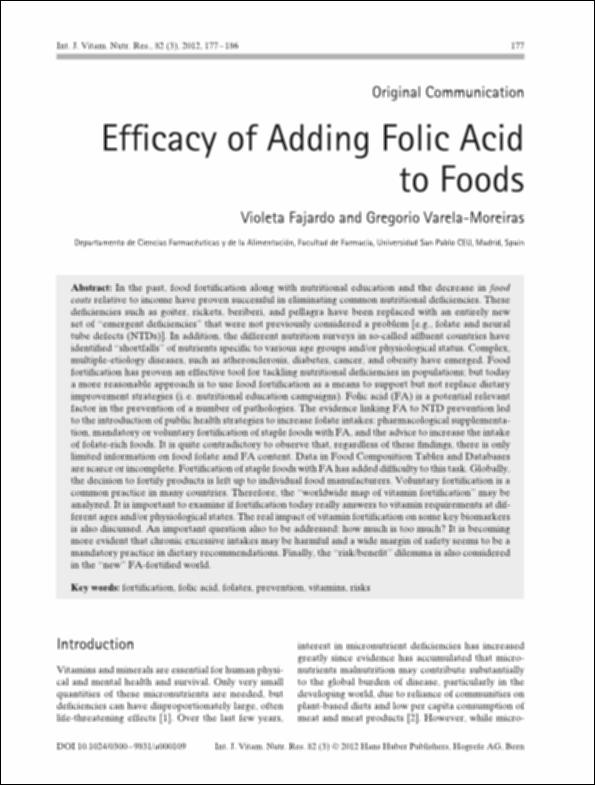Por favor, use este identificador para citar o enlazar este ítem:
http://hdl.handle.net/10637/14110Efficacy of Adding Folic Acid to Foods
| Título : | Efficacy of Adding Folic Acid to Foods |
| Autor : | Fajardo Martín, Violeta Varela Moreiras, Gregorio |
| Materias: | Fortification; folic acid; folates; prevention; vitamins; risks |
| Resumen : | In the past, food fortifi cation along with nutritional education and the decrease in food costs relative to income have proven successful in eliminating common nutritional defi ciencies. These defi ciencies such as goiter, rickets, beriberi, and pellagra have been replaced with an entirely new set of “emergent defi ciencies” that were not previously considered a problem [e.g., folate and neural tube defects (NTDs)]. In addition, the different nutrition surveys in so-called affl uent countries have identifi ed “shortfalls” of nutrients specifi c to various age groups and/or physiological status. Complex, multiple-etiology diseases, such as atherosclerosis, diabetes, cancer, and obesity have emerged. Food fortifi cation has proven an effective tool for tackling nutritional defi ciencies in populations; but today a more reasonable approach is to use food fortifi cation as a means to support but not replace dietary improvement strategies (i. e. nutritional education campaigns). Folic acid (FA) is a potential relevant factor in the prevention of a number of pathologies. The evidence linking FA to NTD prevention led to the introduction of public health strategies to increase folate intakes: pharmacological supplementation, mandatory or voluntary fortifi cation of staple foods with FA, and the advice to increase the intake of folate-rich foods. It is quite contradictory to observe that, regardless of these fi ndings, there is only limited information on food folate and FA content. Data in Food Composition Tables and Databases are scarce or incomplete. Fortifi cation of staple foods with FA has added diffi culty to this task. Globally, the decision to fortify products is left up to individual food manufacturers. Voluntary fortifi cation is a common practice in many countries. Therefore, the “worldwide map of vitamin fortifi cation” may be analyzed. It is important to examine if fortifi cation today really answers to vitamin requirements at different ages and/or physiological states. The real impact of vitamin fortifi cation on some key biomarkers is also discussed. An important question also to be addressed: how much is too much? It is becoming more evident that chronic excessive intakes may be harmful and a wide margin of safety seems to be a mandatory practice in dietary recommendations. Finally, the “risk/benefi t” dilemma is also considered in the “new” FA-fortifi ed world. |
| Descripción : | En: International Journal for Vitamin and Nutrition Research. e-ISSN. 1664-2821. v. 82, (2012) : 177-186 |
| URI : | http://hdl.handle.net/10637/14110 |
| Derechos: | http://creativecommons.org/licenses/by-nc-nd/4.0/deed.es |
| Fecha de publicación : | 1-mar-2012 |
| Centro : | Universidad San Pablo-CEU |
| Aparece en las colecciones: | Facultad de Farmacia |
Los ítems de DSpace están protegidos por copyright, con todos los derechos reservados, a menos que se indique lo contrario.


